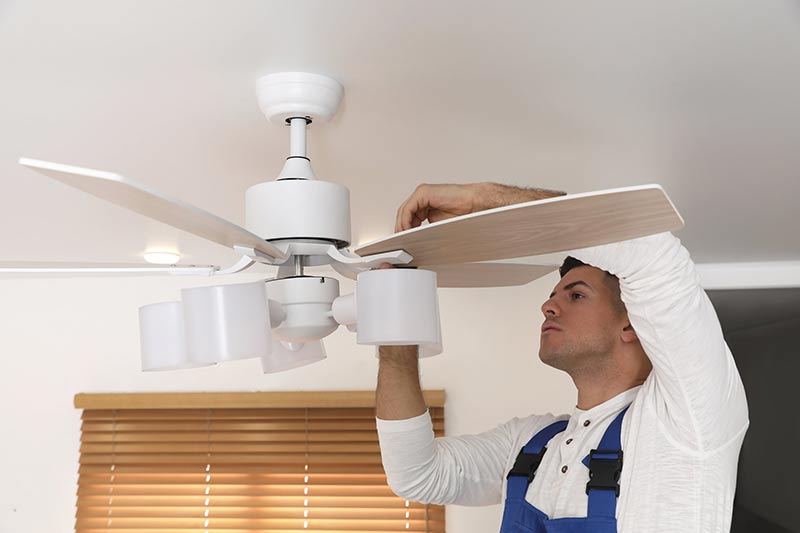Is your ceiling fan going too fast? You might want to use heavier blades. Slow the fan down in 5 steps.
Ceiling fans are the perfect example of “if it ain’t broke, don’t fix it”, as they’ve been around for decades without undergoing severe design changes.
That said, there’s nothing more inconvenient than having your ceiling fan fail on a hot day.
If you’re in such a situation, you need answers, and you need them fast. Below, you’ll find a list including 5 simple steps to reduce your ceiling fan speed, so you don’t have to worry anymore.
Are you ready? Let’s get to work!
Fixing a Speeding Ceiling Fan
When your ceiling fan is spinning too fast, many causes could be putting you in such an inconvenient situation – from something as simple as imbalanced blades to more complex issues, such as a bad or shorted internal component.
Here are the 5 steps you can take to slow down your ceiling fan:
- Check your fan blades.
- Check your capacitor.
- Check your controller.
- Install larger fan blades.
- Use heavier fan blades.
#1 Check Your Fan Blades
When your ceiling fan is spinning too fast, the first thing I recommend to check is the balancing on the blades.
From what I’ve seen, even the slightest variation in how the blades are balanced can greatly affect your fan’s functioning. Your ceiling fan is designed to work under very specific conditions.

When the balance on your blades is off, the speeds you set can vary greatly, causing your fan to spin too fast, even on the lowest settings.
Also, poor blade balance can make the entire fan wobbly, resulting in short circuits, motor damage, and overheating.
Solution: Check your ceiling fan for improper balancing occasionally.
You can fix imbalanced blades by tightening the base screws, leveling the blade lengths, or even adding some special fan weights. If you think adding fan weights is the best solution, you can easily find them cheaply at any online marketplace.
#2 Check Your Capacitor
When your ceiling fan blades are spinning too fast, checking the capacitor is a good idea.
The capacitor is responsible for activating the motor that makes your fan blades spin. Without the capacitor, you’re stuck with a big, static, useless chandelier.
In my opinion, what makes a capacitor malfunction so tricky to diagnose is that things can go one of two ways. You can either be stuck with a ceiling fan that does not turn on or one that spins too fast, even at the lowest settings.
If your ceiling fan is going too fast, and you suspect a bad capacitor to be the culprit, please stop using it immediately, as it can short-circuit and sustain permanent damage.
Solution: Replace the capacitor by following the steps below:
- Carefully turn off your breakers to interrupt all electrical current to the ceiling fan.
- Remove the light bulbs and their housings.
- Undo the screws in the motor holding the outer metal panel.
- Expose your fan’s capacitor and all its other internal components.
- Test the capacitor for continuity with a multimeter if you have one.
- Replace if necessary.
Many more steps exist to replace a faulty capacitor, but the instructions above can help greatly. For a more complete walkthrough, there are several online videos you can check out and follow along.
#3 Check Your Controller
If your ceiling fan is still going too fast, and none of the solutions above have worked out for you, looking at your remote controller (if your fan has one) is not a bad idea.

I’ve found that a faulty remote controller can explain why the blades are spinning like they’re trying to take off even after setting your ceiling fan to the lowest settings.
If you suspect your fan’s remote is failing and want further confirmation, my usual advice is to listen for a ‘beep’ when you hit any button on the remote.
Solution: Try setting your fan to the lowest settings manually and see if the issue is resolved. Provided that the operating speed is corrected by adjusting the settings without using the remote, you’ll know for sure that the remote was to blame.
You can easily get a remote controller replacement by calling your manufacturer. Your manufacturer should be able to get you a new remote for free if you’re still under coverage.
#4 Install Larger Fan Blades
Buying the right-sized fan blades for your appliance is essential to guarantee its optimal operation.
If your fan blades are too large for your motor, you’ll probably experience overheating and many other issues, whereas if they’re too short, you could be stuck with a ceiling fan that is going too fast.
Your motor is very sensitive to even the smallest changes and is designed to use a specific amount of force to make the blades spin at different speeds.
While your manufacturer should have installed the right-sized blades for your specific model, there’s always room for human error.
Solution: Read your user manual if you still have it. More often than not, you should be able to find the recommended blade dimensions in there.
In case your fan has, in fact, the wrong-sized blades installed, replacing them is not very difficult, but if you ever feel doubtful or unsafe, do not hesitate to call a technician for help.
#5 Use Heavier Fan Blades

When your ceiling fan is spinning too fast, you should also check the blades’ weight.
Ensuring your fan blades are the correct length is useful, but weight also matters – especially to your fan’s motor. The combination of optimal weight and length guarantees that your ceiling fan will work as expected.
I’ve found that installing excessively heavy fan blades can put your motor under unnecessary stress and reduce your fan’s lifespan significantly.
Solution: Please read your user manual. In 99% of cases, you’ll be able to find the right specifications for your ceiling fan model in it.
When Should You Call a Pro?
The answer to this will depend greatly on two things:
- The status of your warranty.
- The source of the problem.
If you’re still under coverage and don’t mind waiting for a technician to visit you, by all means, give them a call. Unless specified otherwise, your manufacturer should be able to take care of the repairs for free.
Provided that your warranty has expired, you can do the repairs yourself. But if you determine that the source of the problem lies with the appliance’s electrical installation, I strongly advise you to contact a professional electrician to take care of the job.
Conclusion
Having your ceiling fan going too fast, even at the lowest settings, can be a nightmare. Especially when you’re only looking to get a little breeze going around the room you’re in.
Luckily, as you’ve hopefully learned from this piece, addressing most of the issues related to this situation is fairly simple and quick. More often than not, double-checking your remote controller and ensuring your fan blades are balanced is all you need to do to get your unit back to normal.
Thank you so much for sticking with me all the way to the end. If you found this article helpful, please check out our other guides and free resources below and consider subscribing to our newsletter.
Enjoy the breeze!
-Craig.








